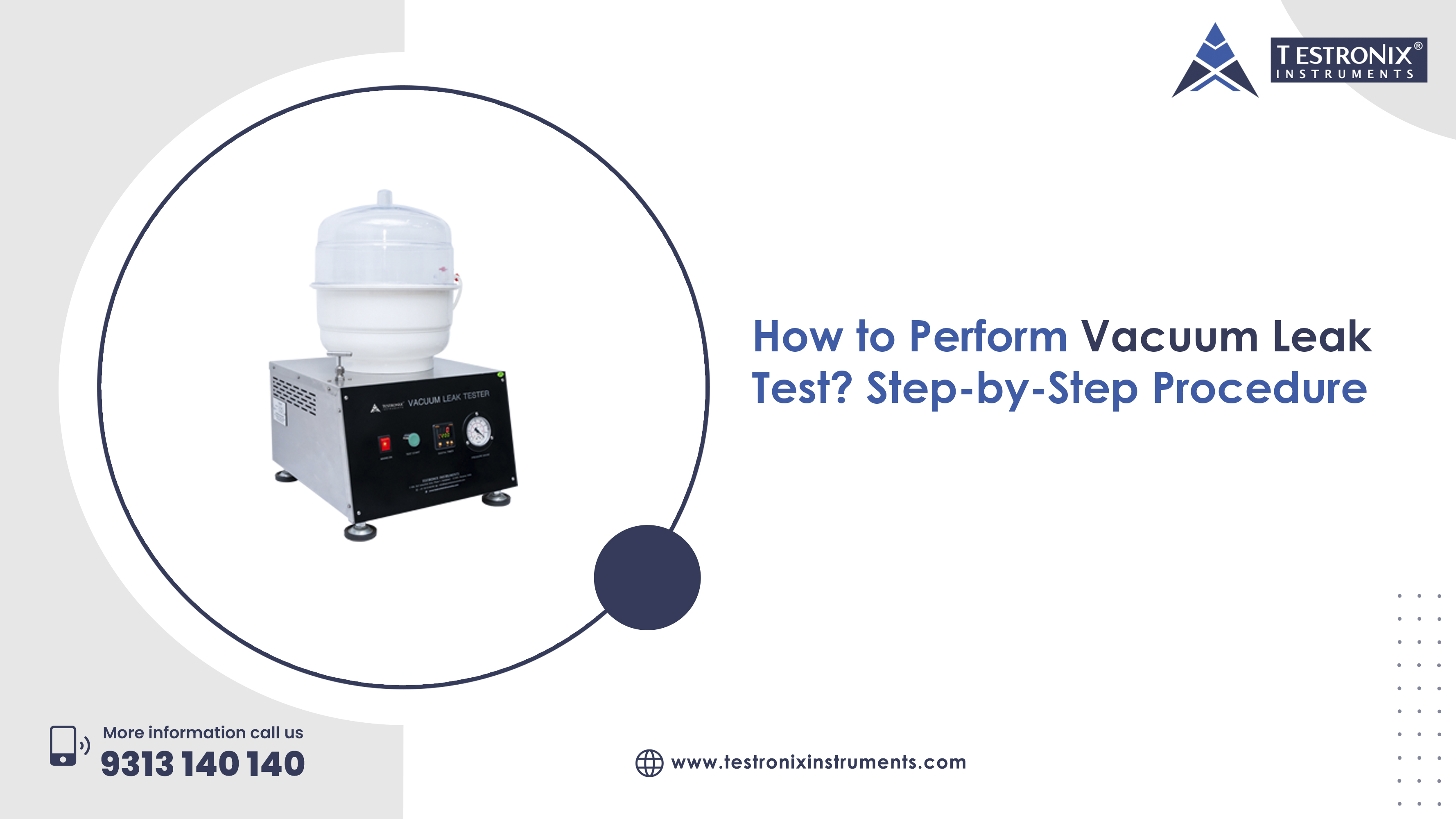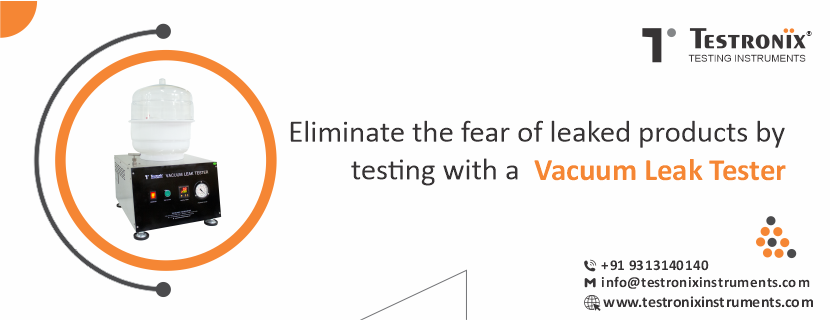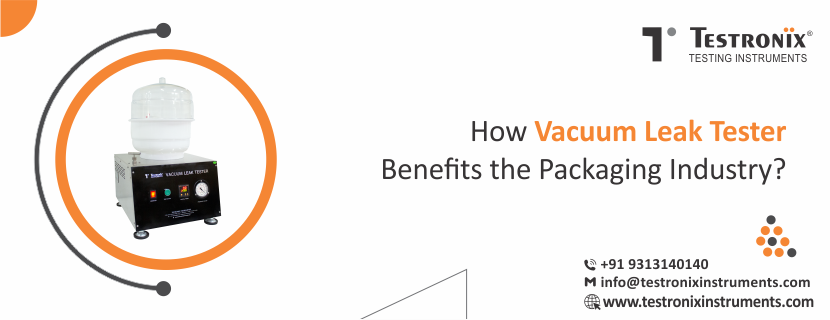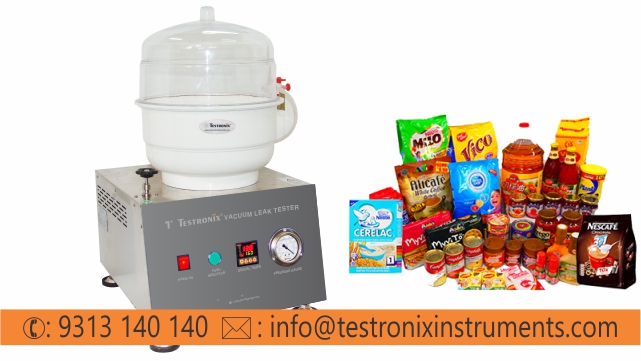In industries where product safety and integrity are an absolute necessity, leak testing is essential. The vacuum leak testing is perhaps one of the most popular methods of detecting leaks. This test, from food and pharmaceutical packaging to automotive, electronics, and aerospace parts, verifies that materials and products are totally airtight to prevent product loss, mechanical failure, or contamination. Passing a vacuum leak test successfully depends on comprehending the principles, instruments, and proper procedures that ensure accurate results.
This article describes what vacuum leak testing entails, why it is necessary, the types of leaks to be tested, the step-by-step process, equipment used, standards involved, and the best practices to enable accuracy.
What is Vacuum Leak Testing and Why is it Important
Vacuum leak testing is a method used to detect leaks in sealed systems or components by creating a vacuum and monitoring pressure changes. It helps identify tiny leaks that could compromise product performance, safety, or integrity, commonly used in industries like electronics, automotive, and packaging. It aids in minimising product recalls and returns, brand image maintenance, regulatory compliance assurance, and product life improvement in industries.
The importance of vacuum leak testing is in:
-
Product Integrity: Guarantees packages or components are correctly sealed.
-
Safety: Avoids risks due to gas leaks in pressurized equipment.
-
Quality Control: Detection of production flaws early to minimise wastage.
-
Regulatory Compliance: Several industries, particularly pharmaceuticals and food, need leak-free packaging for cleanliness and safety purposes.
Types of Leaks to be Tested
-
Gross Leaks
Gross leaks are big openings or flaws through which there is a large passage of air, gas, or fluid. They are typically the result of incorrect sealing, mechanical damage, or defective closures. Gross leaks are the simplest to identify in vacuum leak tests as pressure changes occur instantaneously and are often detectable with bubble emission techniques.
-
Fine Leaks
Fine leaks are microscopic and tiny, frequently too small to be seen by the naked eye. They can degrade product integrity with time, even if they cannot be revealed by simple visual checks. Vacuum leak testing is successful only with sensitive instruments, like vacuum decay systems, capable of detecting minute pressure drops and locating such leaks.
-
Virtual Leaks
Virtual leaks are not real openings in the physical sense but trapped gases within cavities, threads, or porous materials that seep out slowly under testing. Virtual leaks can resemble actual leaks and result in misinterpretation of the results. High-quality calibration, conditioning, and operator vigilance are necessary to identify virtual leaks during a vacuum leak test.
-
Permeation Leaks
Permeation leaks happen when vapors or gases slowly pass through the material itself, instead of leaking through a structural flaw. This is typical in plastics and polymer packaging and is a natural process, not an actual "leak." While performing vacuum leak tests, material permeability must be known in order to prevent misinterpretations of failure.
Step-by-Step Procedure to Perform Vacuum Leak Test
Step 1: Preparation of the Sample
Clean the product dry and remove any contamination, and then inspect seals and closure points for obvious defects, and label and condition the sample as needed, recording lot and test parameters. Repeatability and avoidance of false positives due to surface water, debris, or transitory faults are provided by proper handling and consistent preconditioning.
Step 2: Placement in the Test Chamber
Carefully set the sample within the vacuum chamber, making it rest on a stable fixture firmly without stress. Position sensors, tubing, and any fixtures away from potential accidental leaks. Check chamber seals and closures, then record setup configuration. Proper placement reduces mechanical stress and maintains uniform exposure to vacuum for testing.
Step 3: Evacuation of Air
Gradually start the vacuum pump to achieve the target test pressure, closely observing pump speed and chamber pressure in real-time. Prevent high-speed evacuation that may lead to material deformation or release of trapped air. Equilibrate to the target vacuum, providing thermal and pressure equilibration time. Keep pump and gauge records to prove controlled evacuation and reproducibility.
Step 4: Observation of the Change in Pressure
Measure pressure using calibrated gauges or decay meters for a specified dwell time. Measure vacuum decay rate or mass-flow indicators with high precision, smoothing noise. Compare measured change against acceptance criteria. Ongoing logging with timestamped data assists in determining anomalies. Zero and compensate for ambient temperature and instrument drift in sensors.
Step 5: Analysis of Results
Interpret test data against acceptance standards, separating gross, fine, virtual, and permeation-related signatures. Utilize statistical or threshold-based decision rules, and record pass/fail results using annotated plots or logs. Analyze outliers by inspecting setup notes and instrument calibration records before finishing. Store results for traceability and audits, and regulatory inspection.
Vacuum Leak Tester: Equipment for Vacuum Testing
A vacuum leak tester is a quality-control device that determines the integrity of sealed products, packages, or parts. It establishes a controlled vacuum and measures pressure fluctuations to identify any leakage.
Through the simulation of conditions in which air or gas might escape, the tester verifies packaging strength, sealing reliability, and product safety. It is used extensively in pharmaceuticals, food packaging, automotive, electronics, and aerospace industries where airtight sealing matters.
Key Features of a Vacuum Leak Tester:
Vacuum Chamber
The metallic or transparent chamber encloses the sample during testing. Its heavy-duty construction provides stable vacuum conditions and permits visible leak detection in some test methods, like bubble emission.
Vacuum Pump
The high-efficiency pump generates the needed negative pressure. Adjustable vacuum capacity makes it possible to test various types of products, ranging from sensitive packaging films to rigid containers and mechanical parts.
Digital Display and Controls
Today's testers have digital interfaces that show pressure reading in real-time, leak rates, and test time. This enhances accuracy and facilitates fast analysis by operators.
Adjustable Vacuum Settings
Test parameters can be programmed by users to meet specific product standards and industry specifications. Adjustable levels ensure flexibility and allow the tester to be used in a variety of applications.
Leak Detection Sensors
High-end models have sensitive sensors that identify even the slightest pressure decrease, allowing identification of thin leaks that may otherwise remain undetected.
Ergonomic Construction
Constructed using corrosion-proof materials, the equipment guarantees extended service life, even with prolonged industrial operation. Compact constructions also render them simple to incorporate into production lines or laboratories.
Data Recording and Connectivity
Most testers today also offer data logging, USB transfer, or wireless connectivity so results can be saved for auditing, compliance, and quality assurance uses.
Important Standards for Vacuum Leak Test
Common vacuum leak testing standards are the ASTM D3078/D3078M, ASTM F2338, ASTM D4991, ASTM D6653, and ISO 14457, which are mainly for container and package integrity in the packaging and pharmaceutical industries. These standards prescribe methods to detect leaks.
-
ASTM D3078/D3078M: This standard checks flexible packaging for leaks by immersing the package in water and subjecting it to a vacuum to identify bubbles, which are an indicator of a leak.
-
ASTM F2338: This non-destructive test standard is applied to identify leaks in rigid and flexible packages through a vacuum decay test.
-
ASTM D4991: This destructive technique checks the leak integrity of empty rigid containers by submerging them in liquid and subjecting them to a vacuum to identify any leaks.
-
ISO 27895: This standard deals with leak testing techniques for vacuum technology, specifically for valves.
-
ASTM D6653: This standard is intended to establish the effects of high altitude on packaging systems by applying the vacuum method to simulate conditions encountered during transportation at high altitudes.
A successful vacuum leak test involves a clear knowledge of leak types, proper equipment usage, and conformity to set standards. It is an essential quality control process in industries where product performance and safety are paramount. With a well-formulated procedure, proper application of high-technology vacuum leak testers, and strict compliance with ASTM, ISO, and USP standards, manufacturers can produce defect-free products and gain customer confidence.





